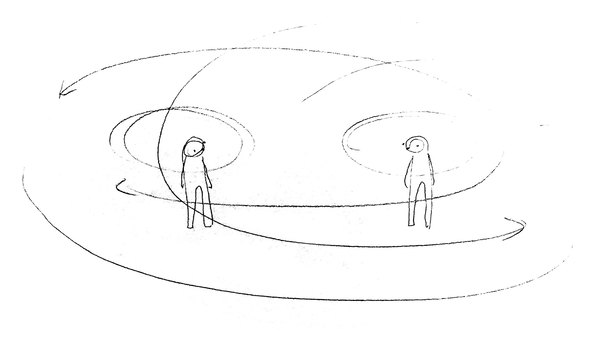We know that sound is transmitted in the form of audio waves. The most accessible visual analogy is ripples on water’s surface. Air is one of the main conduits for the transmission of sound waves Imagine that invisible air transmits sound like ripples on water. You can sense sound but cannot see the path of the soundwave’s progression.
Sound waves that move like water ripples can be transmitted faster and further through a solid conduit. The most often used visualization is: you can hear the sound of a train hundreds of meters away on the traintracks. Imagine the train track working to transmit sound, like ripples through water. Could it be that what we believe to be in a solid state is not a perpetually stagnant and consolidated material existence?
Is time perpetual? Is space eternal? Is there an objective physicality in the material world? Einstein may have unwaveringly believed this to be true, but quantum mechanics seems to tell us that the appearance of the material world varies depending on the different ways we perceive its existence.“No. 103” is a double ringed enclosed space within which the flowing element is a pure-frequency sound. By observing the standing wave phenomenon1 using a Kundt tube sealed at both ends, the principles of acoustic resonance and interference can be understood:2 the static points are called nodes (silent), and the highest amplitude between two adjacent nodes is called the antinode (loudest).
How can the audience sense the existence of sound waves within this enclosed space? Perhaps the easiest method is to, first, be conscious of the change; theoretically the silent node exists a step away from the loudest acoustic resonance. “Being conscious of change” seems like a moment of “encounter” in daily life. The audience may not notice the dynamics of changing soundwaves, but as mentioned above, soundwaves are actually invisible energy transmitted by vibrations in the conduit. In other words, whether the audience is conscious of it or not, the body has become the conduit for the sound waves resonating in space.
〔Notes〕
1. Standing wave: A composite wave formed by two waves moving in opposite directions with the same amplitude and frequency. The shape of this wave cannot progress, so cannot conduct energy, hence the name.
2. Sound interference principle: http://163.13.111.54/general_physics/OSC_Ch-16_sound.html.
Composer and Sound Design: HUANG Ling-Hsuan
Sound Engineering Team: Taiwan Sound Lab, DEAN Chi-You
Special Thanks: HSIEH Ta-Liang, LIN Jin-Yao, WU Ping-Sheng

